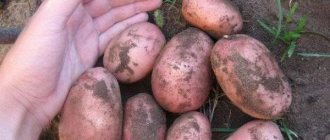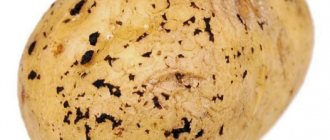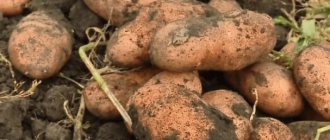Description of the potato variety Breeze
The culture belongs to the mid-early varieties. Harvesting is possible 60-80 days from the moment the seeds are planted in the ground. Characteristics of the Breeze potato variety: plant of medium height, semi-erect. The main stem is thin and has a slight anthocyanin color.
The leaf blades of potatoes are large, matte, dark green in color, with slightly wavy edges. There is no ivy. The inflorescences are simple, white in color.
Important! Potatoes of the Breeze variety are characterized by early tuberization, they respond positively to fertilizing with minerals, and are able to grow on any type of soil.
Harvesting
Harvesting can begin 2-2.5 months after planting. For faster ripening of root crops, you need to remove the potato tops in advance, no earlier than 2 weeks before harvesting.
We invite you to familiarize yourself with potato varieties that have different ripening periods:
| Late ripening | Early ripening | Very early | Mid-late | Mid-early |
| Nikulinsky | Borovichok | Forty days | Crane | Yanka |
| Cardinal | Elmundo | Karatop | Sorcerer | Giant |
| Rocco | Felox | Riviera | Mozart | Tuscany |
| Kiwi | Bellarosa | Zhukovsky early | Grenada | Purple Haze |
| Ivan da Marya | Natasha | Farmer | Melody | Openwork |
| Picasso | Ariel | Minerva | Margarita | Santana |
| Asterix | Queen Anne | Veneta | Ramona | Desiree |
| Slav | Arosa | Kiranda | Dolphin | Lady Claire |
Taste qualities of Breeze potatoes
The tubers are oval in shape and large in size. 8-12 pieces are formed in one bush. The skin is yellowish in color and slightly reticulated. The depth of the eyes is 1.1-1.3 mm.
The light sprout of the tuber has a conical shape, the base is red-violet, and slightly pubescent.
According to reviews and characteristics, Breeze potatoes have high taste qualities and are suitable for use as food (on a tasting rating scale of 7 points).
The tubers are slightly boiled, contain up to 16% starch, 20.1% dry matter and 0.21% sugars. The harvested crop is distinguished by its high shelf life and marketability, so the vegetable is grown not only for personal needs, but also for the purpose of sales.
Pros and cons of the variety
The Breeze potato was developed relatively recently, but is already successfully competing with proven varieties.
Main advantages:
- long shelf life;
- attractive appearance, which allows the variety to be successfully put up for sale;
- good immunity: resistance to scab, cancer and mosaic.
The disadvantages of the variety include weak resistance to nematodes and late blight, which requires additional effort and costs for prevention and pest control.
Planting and caring for Breeze potatoes
Breeze potatoes can be grown in different regions with different climates. Productivity is affected by compliance with the rules of soil preparation, planting and caring for vegetables.
Selection and preparation of a landing site
The initial stage of planting the Breeze variety is digging and fertilizing the soil. In the fall, the garden is plowed to a depth of a spade, and in the spring the remaining weeds and roots are loosened and removed.
The area for potatoes should be located in an open and well-lit area. There should be no slopes, drafts or winds. If it is impossible to prepare the soil for potatoes in the fall, it is processed in the spring. To do this, during digging, weeds are removed and mineral supplements are added.
Potato tubers of the Breeze variety are selected for sowing in the fall, after which they are moved to storage in the cellar until spring. They are prepared for planting a month in advance. To do this, they are taken out and sorted: rotten, pest-damaged or sluggish seeds are discarded, the rest are rinsed in a solution of potassium permanganate and laid out in one layer. If necessary, the disinfectant can be replaced with Maxim or Prestige.
The place for drying the tubers should be warm: this will help them germinate faster. To stimulate the process, the drugs Poteytin or Micom are used. The first shoots appear 13-15 days after treatment. The eyes should be short but thick. A couple of days before planting, the tubers are covered with a hardening bag.
Important! It is recommended to use medium-sized root vegetables as seedlings; if necessary, large potatoes are cut into pieces.
Landing rules
The most common method of cultivating Breeze potatoes is planting under a shovel. The procedure involves digging a hole up to 10 cm deep, followed by placing fertilizers and tubers in it, and then covering it with earth and leveling it.
The distance between rows does not exceed 70 cm, and between holes no more than 40 cm. It is necessary to take into account the soil structure: for sandy loam, the depth of the hole is no more than 8-10 cm, for loamy soil up to 6 cm. If it is necessary to plant whole tubers, the soil is shed with water.
In regions with increased precipitation, they prefer to plant Breeze potatoes in ridges. This method does not allow the root system to die from lack of air during heavy rains. Precipitation flowing down will not interfere with the growth of the crop.
For planting, ridges are created using a plow or cultivator while maintaining a distance of 60-70 cm (the height of the embankments is up to 15 cm), after which potato tubers are placed in them to a depth of 5-6 cm. A space of 30 cm must be left between the holes.
According to reviews, Breeze potatoes in dry areas are grown in trenches. The method requires preparation: in the fall, small ditches are marked and dug. The depth of the trench for potatoes is 30 cm; a distance of 70 cm is maintained between rows.
Fertilizers are applied to the soil and mixed well. Useful additives for potatoes are manure, compost or ash.
The tubers are placed at a depth of 5 cm and covered with mulch on top. To reduce the risk of damping off the bushes during the rainy season, drainage ditches are formed along the edge of the ridge.
Watering and fertilizing
During the period of growing Breeze potatoes, it is necessary to moisten the soil in a timely manner. The first procedure is carried out before the emergence of shoots, the second during the formation of buds, and the third after flowering.
The optimal care regimen for this potato variety is to water it once a week with plenty of liquid. Its deficiency is reflected on the tops: they become less elastic and gradually wither. To correct the situation, watering is urgently carried out so that the water penetrates to a depth of 40-50 cm.
It is forbidden to moisten the soil during the day in the heat: there is a high risk of tuber death. The optimal time to water the soil is late evening.
The first feeding is carried out a month after planting the Breeze potatoes: in the northern regions in June, and in the southern countries in May. Superphosphate, sulfate and urea are added per 1 m2 in a ratio of 2:1:1. To do this, the preparations are dissolved in water or sprinkled along the rows.
Bird droppings have a positive effect on potato yields: up to 200 g of the product is needed per 1 m2. Excessively lush or rapidly growing tops are a sign of an excess of nitrogen fertilizers, so urea or ammonium nitrate is excluded from the list of fertilizers.
The second feeding is carried out after the formation of buds, and the third at the end of flowering.
It is recommended not to neglect foliar feeding methods for Breeze potatoes: irrigate them with potassium fertilizer or Bordeaux mixture.
Loosening and weeding
Timely destruction of weeds and loosening of the soil is carried out as necessary. If sow thistle or wheatgrass predominate among harmful plants, it is possible to use the herbicides Panther or Fusilade. It is recommended not to abuse these funds.
Hilling
This procedure is not necessary if potatoes are grown in southern regions with low rainfall. Hilling will lead to the destruction of the crop, since watering the bushes will be difficult. The procedure is replaced by loosening when a crust forms, preventing the roots from breathing.
In the North, with changes in temperature and precipitation, hilling is an integral part of care. In cold areas, the procedure is carried out immediately after the sprouts appear to protect them from sudden frosts.
It is recommended to hill up Breeze potatoes in the morning or evening, making sure to water the soil first. The procedure is carried out twice: after the shoots reach 12-15 cm and again after 20 days.
Preparation of planting material
Tubers need to be prepared for planting
- For two weeks, the tubers are kept in the light at a temperature of 13 degrees. For hardening, two days before planting, the tubers need to be covered with bags. If you have it, you can even use hay or straw or any material for insulation. You can check the soil temperature using a thermometer, placing it 10 cm deep. The soil temperature plus should be about 8 degrees.
- You should also add potassium and superphosphate fertilizers to the soil, and then dig up the soil for planting. The holes are dug according to the following pattern: depth - 10 cm, distance between holes - 40 cm, between grooves - 70 cm. This pattern ensures free passage, and during flowering and growth, dense thickets do not form, which also affects the nutrition of the plant and its yield.
- We place the tubers in the holes with the germinated eyes facing up, and cover the top with nutritious soil with the addition of ash. This method protects the plant from pests and a number of diseases.
Storage
Dig up Breeze potatoes in dry weather so that the tubers can dry out in the sun.
After a couple of hours, they are cleared of the soil and sorted, separating large fruits for food and small ones for livestock. Medium-sized potatoes are set aside separately for sowing next year.
At the end of sorting, Breeze potatoes are irrigated with antifungal agents Fitosporin or Baktofit, after which they are placed in containers for transportation to the storage site.
The optimal temperature to preserve the integrity of the tuber is + 2-4 °C. Under such conditions, Breeze potatoes do not form roots and are not exposed to low temperatures.
Reviews about Breeze potatoes
Diaghileva Antonina Ivanovna, 61 years old, Yaroslavl
I grow the Breeze potato variety in my garden because of its qualities: it doesn’t overcook, doesn’t lose its taste, and stores well. There are no special care conditions: during the dry season, additional watering and loosening are required. High yields allow you not only to feed your family, but also to sell the surplus.
Semenova Evgenia Aleksandrovna, 56 years old, Ryazan
I have been growing Breeze potatoes in my family for more than 3 years. We love the variety for its taste and pleasant appearance. To prevent pests and diseases, it is necessary to use antibacterial drugs before planting and during cultivation, and carry out hilling and watering in a timely manner. The harvested crop pleases with good keeping quality without loss of taste.
Features of cultivation
The agricultural technology for growing Breeze potatoes is standard, but has several features:
- It is advisable to moisturize weekly. Water can be poured into the rows at the rate of 1 bucket per 2 bushes.
- It is necessary to fertilize with complex fertilizer or organic matter (dung, mullein, grass infusion) 2-3 times per season.
- Hilling is carried out at least three times: after the sprouts reach a height of 15 cm, then every 2–3 weeks.
- Loosening and weeding - regularly.
Important! In the southern regions, Breeze potatoes are not hilled, since the roots may overheat due to the high mound. Watering, on the contrary, needs to be increased. To help the soil retain moisture longer, it is mulched with straw.
Breeze potato bushes need hilling only in the North-Western regions










